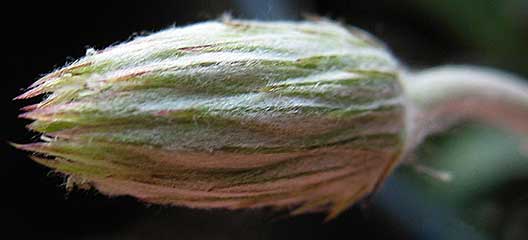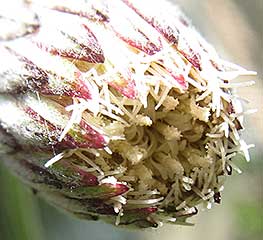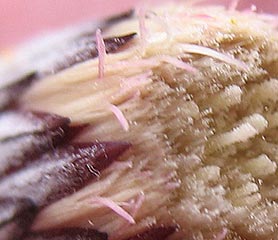
Three C. carduacea heads. The one in the red area is at early anthesis; the others (in yellow) are in advanced bud stages.
Anthesis
by Bob Harms

In view of often conflicting statements in the taxonomic Chaptalia literature it was necessary to define more precisely the period of flowering, i.e., anthesis:
- anthesis
- The period from the initial display of pistillate floret style branches until all pistillate floret style branches are enveloped by pappus bristles; generally 4—7 days. This is most apparent when the pappus of the peripheral florets is exserted from the involucre. The term is here applied to the head as a whole, not individual florets.
In short, anthesis is the period in which at least some florets are open for sexual activity (or, if apomixis is confirmed, have stigmata exserted). Although it might seem that simple inspection of the head permits a determination of when a head is in flower, the situation with Chaptalia is much more complicated. In early spring phase C. texana develops prominent ligules and some forms (but not all) of C. carduacea have visible ligules. But in late spring phase and in summer/fall/winter phase both species have closed heads without visible ligules. In closed–phases the transition from bud to anthesis is often difficult to recognize without a good hand lens.
Head position does not provide a meaningful basis for defining anthesis.
In recent taxonomic literature it is given as:
"erect in flowering" (Nesom 2006)
and
"nodding in flower" (Diggs et al. 1999)
Both are actually correct, but neither characterizes the highly complex behavior of the head/peduncle orientation at this period. These issues are discussed on a separate page.
First days of anthesis: C. texana
The three images below illustrate the first day of anthesis from early (left) to late spring. Only the early spring head begins anthesis with visible ligules, which then rapidly lengthen and spread outward in a raylike manner. Later heads typically have greatly reduced ligules which are not visible during anthesis.
Also generally visible at this stage are the many style branches of pistillate florets and the anther tubes of the central perfect florets (crimson–tipped) with small clumps of pollen at the top — the style branches, having pushed out the pollen, are not exserted.
|
(Place cursor on image for date. Click for larger image.)
|
 |
 |
 |
The leftmost head above 2 days later. It was cernuous at midday (left) but by 3:30 had risen (rightmost).
The following C. texana head on the first day of anthesis, April 14 — late–spring phase, already had long pappus and style branches were barely visible. How did I know it was the first day? This head and the others on this page were on plants that I monitored several times a day for several months, from late February through mid April. This was the first day the head was not closed, although it appears to be at an advanced stage of anthesis. One possibility is that the achenes had already become fertile asexually (via apomixis) and/or, in the case of the central perfect florets, sexually (via cleistogamy). This issue is still under investigation as of summer 2011.
First days of anthesis: C. carduacea
The three images below illustrate the first day of anthesis for the form of C. carduacea with heads that barely open in all seasons and lack exserted ligules in early spring, left to right from March 17, March 25 and July 8. The middle photo shows a perfect central floret and, with enlargement, pollen can be seen on the style branches.
|
(Place cursor on image for date. Click for larger image.)
|

|

|

|
The corresponding heads (left to right) on day 2 or day 3 of anthesis are open wider, but nothing like the ligulate C. texana heads. The two March heads now show a great deal of pollen, the July head (on the right - click to enlarge) very little if any at all – the tiny specks may not be pollen.
|
(Place cursor on image for date. Click for larger image.)
|

|

|

|
Last days of anthesis: C. texana
Anthesis was noted to last 7 days with C. texana. In the series for day 5 through day 7 below note the continued lengthening of the pappus, overtaking the style branches. By day 8 it extended beyond the involucre, enclosing even the peripheral florets. The ligules and phyllaries no longer spread outward. The head shown is the same as the one above for the onset of anthesis.
Days 5–7
(Place cursor on image for date. Click for larger image.)
|

|

|

|
|
Days 8 — Post Anthesis
|

|

|
Last days of anthesis: C. carduacea
Anthesis was noted to last 5 days with C. carduacea. In the series for day 4–5 (anthesis) plus day 6 (post–anthesis; rightmost 2 images) the pappus lengthens until it completely envelops the style branches. The head shown is the same as the one above for the onset of anthesis.
Days 4–6
(Place cursor on image for date. Click for larger image.)
|

|

|

|

|
Plant Resources Center Home Page — Flora of Texas
— Chaptalia

























